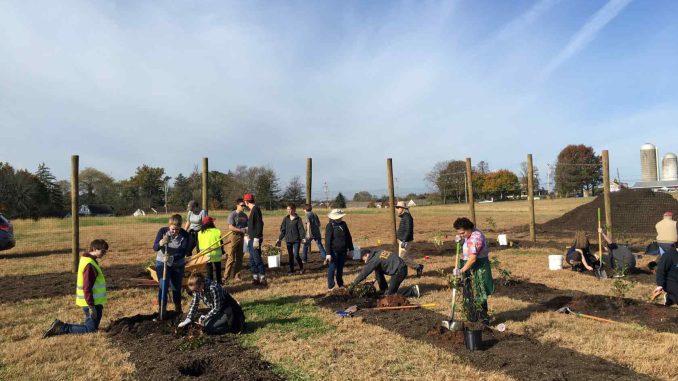
Details
Article by Erin Corcoran <ercorcoran@ursinus.edu>
Calling all green-thumbed Bears! Ursinus’s Food Forest continues to grow into the future.
The Food Forest, located a short walk from campus, is a 1.5-acre site for the campus community to grow native and non-native plants, trees, and food. Per the Food Forest’s website, “food forests mark a commitment to building reciprocal relationships with the region’s many food-producing native trees and shrubs as well as myriad other ecologically beneficial native and nonnative plant species.” The mission of this forest is larger than that, however. Dr. Patrick Hurley, Chair of Environmental Studies and the Food Forest Guardians, students who assist the Forest for academic credit, strive for the forest to help people reconnect with nature and provide opportunities for students to explore unique foods.
The Forest was created by an Environmental Studies (ENV) capstone course in 2017. Since then, there have been two more capstone classes that focused on planting, one in 2019 and the other in 2021. This year, the capstone course, Sustainability in the Suburbs, is continuing this planting initiative but also working with community partners, such as Philadelphia’s Friends Select School and the Lenape Tribe.
Along with departments on campus, the Food Forest also works closely with the Welcome Home Project. Hurley, states, “A key feature of the Welcome Home Project is the College’s commitment to ‘reconciliation among all our communities,’ a point that we at the Food Forest specifically take to mean the inclusion of plant species that are culturally important to members of the Delaware Tribe (one of the officially recognized communities of the Lenape people). Beyond simply including species such as smooth sumac (këlëkënikwënakw in Lenape, which has a flower bundle that can be used to make a lemonade-like drink) or pawpaw (mahchikpiawk in Lenape, which has a wonderful fruit) that allow us to talk about these people/culture-plant connections, we actively work to include species to support the future of the Lenape Culture.” This past Indigenous Peoples’ Day, students observed the holiday by planting tulip poplar and cranberry with members of the Delaware Tribe of Indians.
Currently, Food Forest Guardians are also working to ensure the plants have long-term survival.
Additionally, the Guardians help with harvesting fall crops, such as elderberries, hazelnuts, plums, and pecans. Most planted species are still growing, as they take an average of 4-7 years before producing their consumable parts. A future goal of Hurley and the Guardians is to serve some of the harvested food in Wismer. ENV and other departments collaborate in several disciplines to advance the mission of the Forest. Some courses in Food Study and History have integrated the Forest into their curriculums, with more interdisciplinary work incorporated each semester
Interested students can get involved during annual weekend work once the weather warms up again in Spring. Activities on these days include planting new trees, mulching, and harvesting. Hurley emphasized, “It’s a great way to get away from campus for a while and hang with great people and see some birds!” Food Forest Guardians also include more than students participating in hands-on work. Some Guardians interested in Communications and Arts work on outreach activities, Science-focused students collect data for the Forest, and the Guardians are given the chance to engage in leadership positions. Also, interested ENV students can keep an eye out for Hurley’s ENV-338: Forest and People course, running in Fall 2024 (note: multiple ENV classes before then will be interacting with the Forest).
For latest updates on the Food Forest, follow the Instagram @ursinusfoodforest. Students interested in becoming a Guardian or coming to a weekend event can contact Patrick Hurley at phurley@ursinus.edu.
